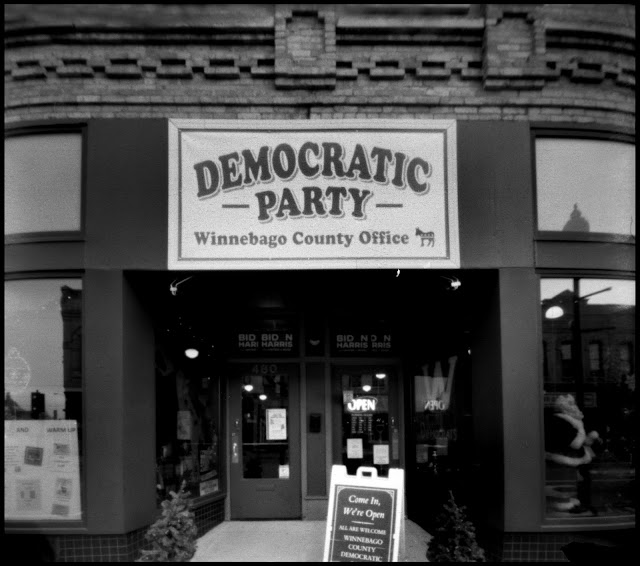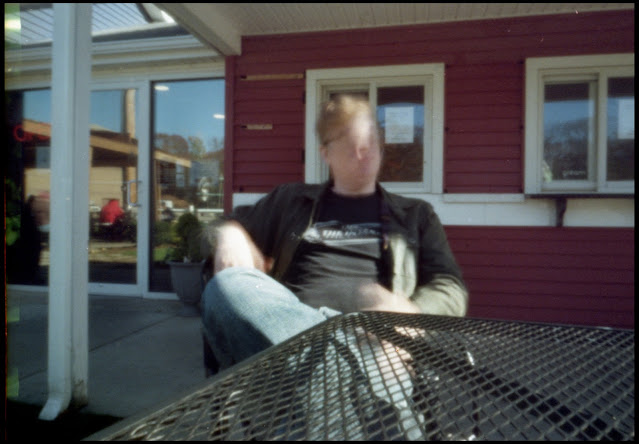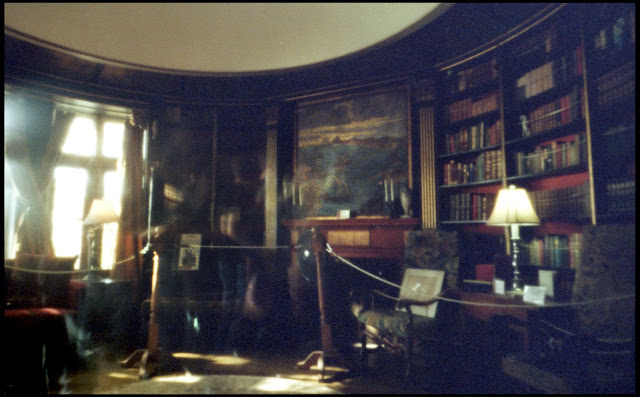The Fox River Valley Photographic Group's challenge this month was "Inspired Me!" The concept was to choose an artist, in any medium, that you found inspiring and then make a photograph based on that inspiration. I didn't look for something new and go and then take photographs based on that, but it was constantly on my mind as I took and looked at the photographs I've taken in the challege period.
The meeting where these were going to be discussed was cancelled due to a snow storm and a new challenge has been presented. I was looking forward to this discussion but I'll just have to write about it here instead.
Everything I've put in these monthly challenges since I started participating has been done with 6x6cm cameras, mostly with black and white. The last few months I've been doing lots of the Roadtrip series using 35mm cameras with 24mm distance from pinhole to color film. The name that kept coming back to me as inspiration was Edgar Degas, specifically this painting, The Milliner's Shop, which he worked on from 1879 to 1886. I saw it in a special exhibition at the National Gallery in London in 2000 and I must have seen it several times in its regular home at the Art Institute of Chicago. We bought an exhibition poster of it which hung in our kitchen for a long time, featuring Degas' distinctive signature beneath the painting. My mother once asked when we had been in Vegas.

Take a look at this from a photographer's point of view. I want to be clear that I'm not suggesting Degas was working from a photograph. If this were camera work it would be pretty darn wide angle. At the top you're looking almost horizontally over the middle hat, and at the bottom you're looking rather downward at the desk. I'd guess we're dealing with something like 70 degrees. With a 6x6cm that's about 45mm from pinhole to film, in 35mm film equivalents, about a 24mm camera horizontally. Lenses that wide-angle were not available at that time.
Our imaginary camera is tilted down quite a bit, but the verticals are perfectly parallel, as though a falling front was used. "Field" cameras with tilts, shifts and rising/falling fronts had been introduced twenty years before for wet plate photography. Degas was familiar with photography and probably knew about camera adjustments but parallel verticals were something painters had been obsessed about for years.
The Kodak wasn't introduced for another ten years, but there were still plenty of amateur photographers. Another thing Degas was familiar with were the sometimes random compositions in what was to become snapshot photography.
We might think of the cropping as kind of tight, but cropping wasn't a concept in painting and drawing. You made the composition to fit your format. No painter would have cut part of the hat off and made the figure so secondary to several seemingly randomly placed piles of color. He also once did a painting with just the back end of a horse on one side of the composition.
 |
| Before the Race - 1893 |
This all reminds me a lot of the uncertainty of what exactly is getting through the pinhole with no viewfinder and just rough pointing measures like sighting triangles.
Another characteristic I percieve in Degas, and the Impressionists in general, is that they made artwork wherever they went. They didn't necessarily need a monumental or historic subject to make a painting. It was just places you saw everyday. Sort of street photography, hey, Mike?
Another more controversial observation is that the image quality is not particularly tack sharp. Impressionist, ya know. Despite exhibiting pictorialist work for over a decade, in the late 1910s and '20s Alfred Steiglitz promoted the concept that photography shouldn't be compared to painting and should be judged by it's own criteria, which it turns out is tack sharp. Group f64 with Ansel Adams, Edward Weston and Imogen Cunningham grew out of that idea. This was the still prevailing dogma when I started in photography in graduate school. I worry about the ghosts of Stieglitz and Adams haunting me when I say my 35mm pinhole work reminds me of the paintings of The Impressionists and that I like it. To complicate matters, another Mike chose Steiglitz as his inspiration so that might have been an interesting conversation.
So here's the photo I submitted for the challenge, done recently during a trip to Massachusets.

It was done with Little Guiness, a 35mm format Populist, 24mm from pinhole to film. Whenever I go anywhere I try to operate under "Populist Rules," which basically say I have to take photographs wherever, despite the lighting and camera support situations not being optimum. It turns out that's not that hard but you do have to look for opportunities. It's hard not to notice an opportunity like this. The subject is my son Andy who isn't fazed by having a camera constantly pointed at him. Our table wasn't going to be ready for twenty minutes so he wasn't going anywhere. The sunlight was fortuitously streaming over the building highlighting his forehead and nose, and his arms and legs. I can just see one of those grad school professors demonstrating how to do this with studio lights. I had a flat table in front of me to put the tripod on. There's nothing blowing around. How could you not take this picture?
I have to admit my composition strategy consisted of just pointing the camera at him, not checking with the viewfinder triangles to see where the edges were. I don't remember doing it, but I probably spent a moment or two making sure the camera was level. I was aware of Andy's high contrast prominence in front of the diffusely lit background. What I didn't notice was the color with Andy's almost monochrome figure against the desaturated warmish background. I love the dark magenta of that clapboard wall. And all those lines, including the table corner and bracing forming an aggressive arrow pointing right at him and the geometric window framing his head - the verticals perfectly parallel of course. The reflection of the light-colored building is visible which was providing the just slightly directional fill light.
And just enough motion blur to make an anonymous, but also, if you know him, recognizable figure.
It's not just recently that I noticed this association with the Impressionists, and for that matter all painting in general. It happened the first time I took color photographs with a 35mm pinhole camera in 2005.
I'd been aware of a lot about composition after typing Sarah's Art History papers and listening to her respond to paintings in museums all over the United States and Europe. I remember three expositions on Degas' more formal early work The Bellelli Family - in the 70's for me with a book and then twice in as many years standing in front of it in the Musée d'Orsay, once for her brother and once for Andy.
I also have to note credit to famous polytech YouTube personality Joe Van Cleave for his series on One Photo Revisited. And about a million others who have influenced me.

































































